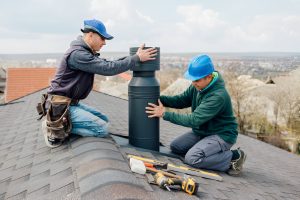Chimney Cap Installation El Paso, TX
Call for a Quote
(915) 266-0067
All Services
Chimney Cap Installation: Protect Your Home and Fireplace

Introduction
Chimney caps are vital components of your home’s chimney system, providing protection against the elements and keeping your fireplace functioning safely and efficiently. If you don’t have a chimney cap—or your existing one is damaged—you’re at risk for water damage, animal intrusion, and even dangerous downdrafts. This article explores the importance of chimney cap installation and how it can protect your home from costly damage.
What is a Chimney Cap?
A chimney cap is a metal cover that sits on top of your chimney, preventing debris, animals, and water from entering the chimney flue. It typically includes a mesh screen to block animals and leaves, and a solid metal cover to prevent rain and snow from entering.
Why Do You Need a Chimney Cap?
- Prevents Water Damage: One of the main functions of a chimney cap is to protect your chimney from rain and snow. Without a cap, water can enter your chimney and cause rust, corrosion, and damage to the structure, including the mortar and brick.
- Blocks Animals and Debris: Birds, squirrels, and other animals often nest in chimneys, creating blockages that can lead to fire hazards. A chimney cap helps prevent animals from entering your home and keeps debris, such as leaves and twigs, out of the chimney.
- Controls Downdrafts: A properly installed chimney cap can help prevent downdrafts, which occur when smoke and gases from the fire are blown back into the living room. Downdrafts can be dangerous and make your fireplace inefficient.
Types of Chimney Caps
- Mesh Chimney Caps: These caps are made of a fine mesh that blocks animals and debris while allowing smoke and gases to escape. They are the most common type for homes with fireplaces.
- Rain Guard Caps: These caps have a solid cover to prevent rain and snow from entering the chimney while still allowing smoke to exit. They are ideal for areas with heavy precipitation.
- Custom Caps: Some homeowners opt for custom chimney caps made from copper or stainless steel for a more aesthetic and durable solution.
Signs You Need a New Chimney Cap
- Visible Damage: If your chimney cap is rusted, cracked, or missing, it’s time to replace it.
- Animal Issues: If you’re hearing scratching noises in your chimney or have found nests, a new cap is necessary.
- Frequent Downdrafts: If you experience smoke blowing back into your home, it may be a sign that your chimney cap is malfunctioning or missing.
How Chimney Cap Installation Works
Installing a chimney cap is a straightforward process for professionals:
- Selection of the Right Cap: A technician will assess your chimney’s size, type, and needs to recommend the best cap for your home.
- Installation: The technician will carefully secure the chimney cap on top of the chimney flue, ensuring a tight seal to prevent issues with water, animals, or downdrafts.
- Inspection: After installation, the chimney cap will be inspected for any gaps or improper seals.
Maintenance Tips for Chimney Caps
- Regular Inspections: Check your chimney cap for signs of wear, rust, or blockage every year.
- Cleaning: Keep the mesh screen clean and free of debris to maintain proper airflow.
- Prompt Repairs: If you notice any issues with your chimney cap, get them repaired promptly to avoid further damage.
Conclusion
Chimney cap installation is a simple yet effective way to protect your home from water damage, animal intrusion, and dangerous downdrafts. If you don’t have a chimney cap or your existing one is damaged, consider installing a new cap to keep your chimney and fireplace in optimal condition for years to come.
